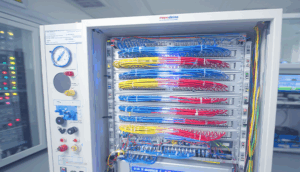CC-Link IE has emerged as a pivotal technology in the realm of industrial automation, offering a robust and high-speed communication backbone for various applications. Its capacity to handle substantial data volumes, coupled with real-time performance, makes it ideal for connecting diverse components within a factory setting. However, as industrial environments evolve, the demand for greater network flexibility grows exponentially. This article delves into how CC-Link IE is being adapted and enhanced to meet these expanding requirements, exploring its current limitations and the innovative solutions being implemented to overcome them.

One key area of focus lies in improving network topology and configuration. Traditional CC-Link IE networks often rely on rigid, pre-defined structures, which can be restrictive when reconfiguring production lines or adding new devices. To address this, newer implementations are incorporating features such as dynamic network configuration and automatic device discovery. These functionalities enable faster and more efficient network adjustments, reducing downtime and improving overall operational agility. Furthermore, advancements in network management software are providing operators with enhanced visibility and control over the entire CC-Link IE infrastructure, enabling proactive monitoring and troubleshooting.
Another significant aspect of enhancing network flexibility involves integrating CC-Link IE with other communication protocols and technologies. As industrial ecosystems become increasingly complex, the need for seamless interoperability between different networks is paramount. Efforts are underway to develop gateways and interfaces that facilitate communication between CC-Link IE and other protocols such as Ethernet/IP, Profinet, and OPC UA. These solutions enable data exchange between different parts of the factory, fostering better collaboration and information sharing. This integration is critical for achieving true end-to-end connectivity and realizing the full potential of Industrial IoT (IIoT).
Security considerations also play a vital role in the evolution of CC-Link IE network flexibility. As industrial networks become more interconnected, they also become more vulnerable to cyberattacks. Therefore, enhanced security measures are crucial for protecting sensitive data and ensuring the integrity of industrial processes. Current efforts are focused on implementing advanced security protocols, such as encryption and authentication, to safeguard CC-Link IE networks against unauthorized access and malicious activities. Regular security audits and vulnerability assessments are also essential for identifying and mitigating potential risks.
Looking ahead, the future of CC-Link IE promises even greater network flexibility and adaptability. Advancements in wireless communication technologies are opening up new possibilities for connecting devices and machines in challenging environments. The integration of CC-Link IE with wireless technologies such as Wi-Fi and 5G can enable remote monitoring, predictive maintenance, and other advanced applications. By embracing these technological advancements, CC-Link IE can continue to play a crucial role in shaping the future of industrial automation and driving the digital transformation of manufacturing industries. The continued development and adoption of these flexible and secure network solutions are essential for maximizing efficiency, productivity, and resilience in the face of evolving industrial demands.